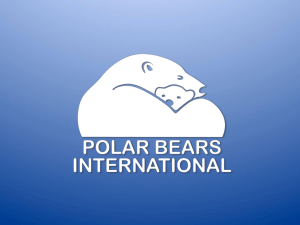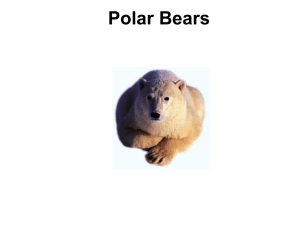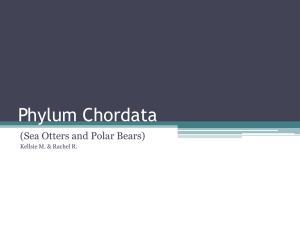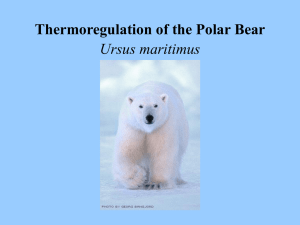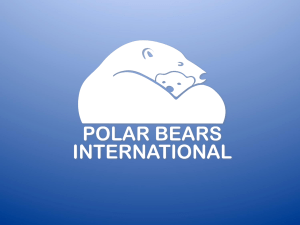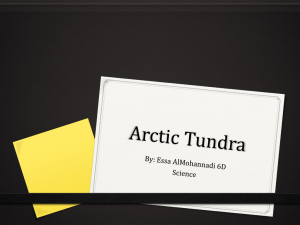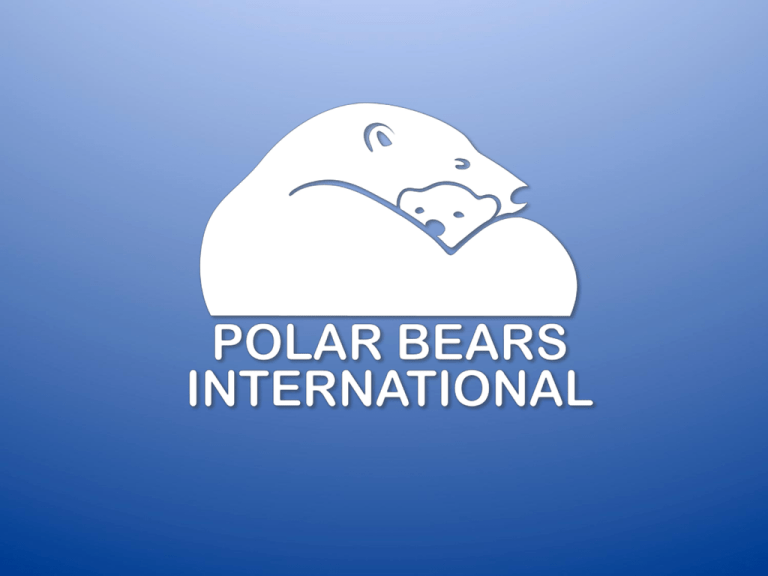
Polar Bear Research
Why do scientists study polar bears?
The Polar Bear
• Perfectly adapted to
the arctic sea ice
• Relies upon sea ice
for critical aspects of
its life history—
feeding, finding
mates, and giving
birth
What Are Scientists Studying?
• Population Dynamics of Polar Bears
o
Population size
o
Reproduction
o
Survival rates
• How Polar Bears Use their Habitat
• Physical Condition of the Polar Bears
How Are Scientists
Studying Polar Bears?
Research Methods
• Capture-recapture Method:
Provides data on population dynamics
• Gathering Physiological & Biological Data:
Documents the physical condition of the bears
• GPS Collar Tracking:
Shows how polar bears use their habitat
How To Study Polar Bears
Step-by-Step
Step 1: Find the polar bear
What does the team look for?
• Tracks
• Leads or areas of
open water or thin
ice where seals
have breathing
holes
• Pressure ridges (ridges of ice) that bears follow
as they travel
Tracks
Can you see the
polar bear?
Pressure Ridge
Step 2: Approach
When a bear is spotted the
team confirms:
• A safe place to land the
helicopter
• That there are no other
polar bears in the area (for
the safety of the scientists
and the polar bear)
• That there is no place
where the polar bear could
run and potentially get hurt
Step 3: Darting the polar bear
This takes skill on the
part of the helicopter
pilot and the scientist
Step 4: Approaching with caution
Step 5: Collecting all possible data
• Time and efficiency are of the essence
• Data is collected from head to toe
What Do Scientists Learn
From Their Research?
Long-term Data Collection
• Collaring &
Tracking Bears
Automated collar release
VHF antenna
GPS antenna
ARGOS antenna
Learning from the Data
166°
156°
146°
136°
126°
116°
Polar Bear 5809: Movements and Observations
21 year old adult female was 400 pounds in April
of 1998 after spending the winter in a den.
She was first captured as a yearling with her brother
and 9 year old mother in the McKenzie River Delta.
Aug 23 '98
&
&
& &
76°
Jul 26 '98
&
&
&&
&
#
Y
&
& &
Sep 13 '98
#
S
&
&
&
&
76°
&
&
&
&
Capture
Observation
Movements Determined
by Satelite Tracking
&
&
116°
Oct 11 '98
&
&
&
&
&
&
&
& &
&
&
&
Aug 22 '99
&&
&
&
&
71°
&
&
&&
&
&
&
&
&
&
Jun 6 '98
71°
&
&
Captured
Nov 5 '97
&
&
&
&&
&
& &
&
#
Y
&
&&
&
&
&
&
Nov 14 '99
&
&
&
&
&
&
&
&
&
X
(&&
&
#
146°
Jan 09
&
&
#
X
(Y
&
50
New
Year's
2000
&
&
&
&
&&
&
&
&
&
&
&
&&
&
&
May
9 '98
&
&
&&
Denned in Angun River
Winter 98 - S pring 99
156°
&
&
&
&& & &
& &
& &
&
0
&&
&
& &&
&
&
&
&&
Captured
Apr 16 '98
Given Radio
&
& &
Hallow een '99
Feb 26
&
100
150
200
&
#
Y
Captured
Apr 12 '79
Area
of
Map
250 Miles
136°
126°
Wild polar bears are the most mobile of non-aquatic mammals.
As with other species, scientists have used radio telemetry to
follow their movements in order to gather information that can
be used to more effectively manage them.
What does it take
to study polar bears?
Background and Behind the Scenes
of Polar Bear Research
Working in the Arctic = Extreme Environment
• Sea Ice
o Variable size, shape,
thickness, amount
o Always moving and
changing
• Weather:
Near Kaktovik, Alaska the mean average
temperature during the research season
can be 10-20°F (without wind chill)
The Scientist in Alaska
Dr. Steven C. Amstrup
“After observing and
capturing hundreds of
polar bears over a 30-year
career … the first bear
sighting of every field
season still invokes a
feeling of ‘Wow! There’s a
real wild polar bear!’ I will
never lose the sense of
awe they inspire.”
The Scientist in Canada
“I became a polar bear
researcher because I wanted
to do my part to help
conserve the animals that
are struggling with the
effects of a changing
environment due to human
activities. By studying polar
bears, I am contributing to
our knowledge about them
and helping to make sure
that they persist for many
generations to come. It's a
very fun and satisfying job!”
Alysa McCall, MSc in Ecology,
University of Alberta
The Photographer
“I enjoy being the explorer
as well as the photographer.
For me photography of the
natural world is more than
just pretty settings and
cuddly animal pictures. It’s a
concern for the environment
and the earth all living
creatures must share.”
Daniel J. Cox
The People Behind the Scenes
What does it take to get ready for fieldwork in the North?
• Careful checklists
• Tools that have been
tested and retested
• Well-organized
equipment
• Individuals who are
skilled at problemsolving, have a can-do
spirit, and can do it all!
The Gear Behind the Scenes
Tools are needed for:
• Safety
• Research
• Back-up supplies
• Storage
Not everyone can study polar bears…but we can ALL
help polar bears and their arctic habitat!
Take steps to reduce
your greenhouse gas emissions:
Live Green
Build Green
Choose Green
Every little bit can make a
difference!
For more information, visit
On behalf of polar bears everywhere,
PBI thanks you!
Photos: © Daniel J. Cox / www.NaturalExposures.com
unless noted.
© 2013 Polar Bears International. All Rights Reserved. Marks and text appearing in this presentation including, but not limited to,
the Polar Bears International name, logo, and programs are trademarks, registered trademarks, or service marks of Polar Bears International.




